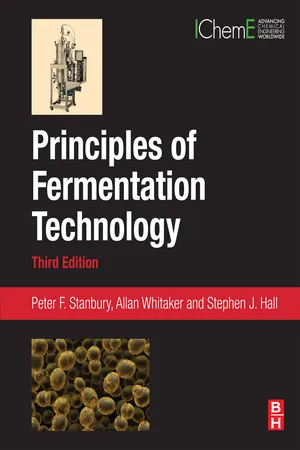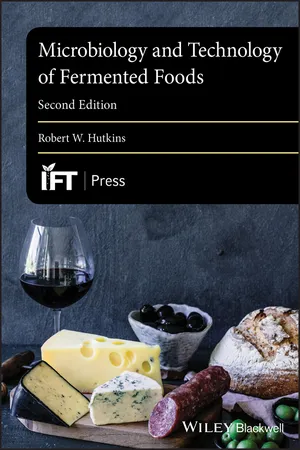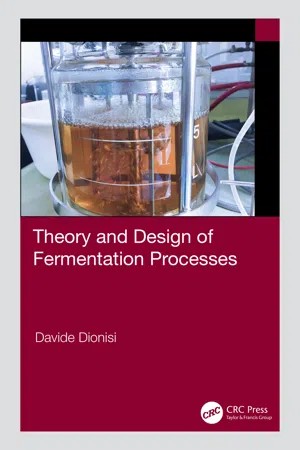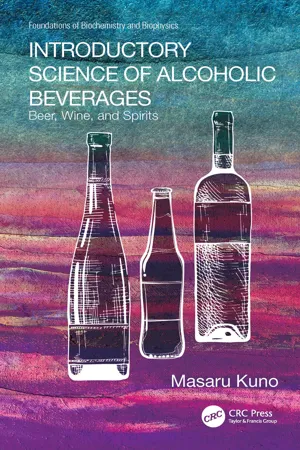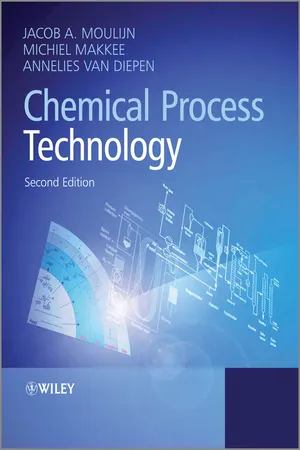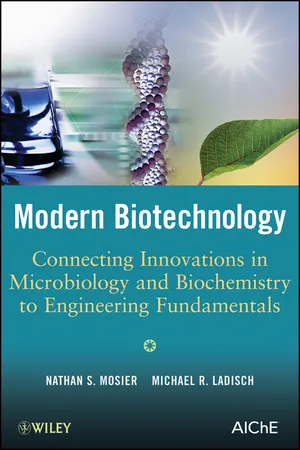Biological Sciences
Fermentation
Fermentation is a metabolic process that converts carbohydrates, such as sugars, into alcohol or organic acids using microorganisms like yeast or bacteria. It occurs in the absence of oxygen and is used in various applications, including the production of alcoholic beverages, bread, and certain dairy products. Fermentation is an important aspect of biotechnology and industrial microbiology.
Written by Perlego with AI-assistance
Related key terms
Related key terms
1 of 4
Related key terms
1 of 3
8 Key excerpts on "Fermentation"
- eBook - ePub
- Peter F Stanbury, Allan Whitaker, Stephen J Hall(Authors)
- 2016(Publication Date)
- Butterworth-Heinemann(Publisher)
The production of ethanol by the action of yeast on malt or fruit extracts has been carried out on a large scale for many years and was the first “industrial” process for the production of a microbial metabolite. Thus, industrial microbiologists have extended the term Fermentation to describe any process for the production of product by the mass culture of a microorganism. Brewing and the production of organic solvents may be described as Fermentation in both senses of the word but the description of an aerobic process as a Fermentation is obviously using the term in the broader, microbiological, context and it is in this sense that the term is used in this book.The range of Fermentation processes
There are five major groups of commercially important Fermentations:1. Those that produce microbial cells (or biomass) as the product.2. Those that produce microbial enzymes.3. Those that produce microbial metabolites.4. Those that produce recombinant products.5. Those that modify a compound that is added to the Fermentation—the transformation process.The historical development of these processes will be considered in a later section of this chapter, but it is first necessary to include a brief description of the five groups.Microbial biomass
The commercial production of microbial biomass may be divided into two major processes: the production of yeast to be used in the baking industry and the production of microbial cells to be used as human food or animal feed (single-cell protein). Bakers’ yeast has been produced on a large scale since early 1900s and yeast was produced as human food in Germany during the First World War. However, it was not until the 1960s that the production of microbial biomass as a source of food protein was explored to any great depth. As a result of this work, reviewed briefly in Chapter 2 , a few large-scale continuous processes for animal feed production were established in the 1970s. These processes were based on hydrocarbon feedstocks, which could not compete against other high protein animal feeds, resulting in their closure in the late 1980s (Sharp, 1989 ). However, the demise of the animal feed biomass Fermentation was balanced by ICI plc and Rank Hovis McDougal establishing a process for the production of fungal biomass for human food. This process was based on a more stable economic platform and has been a significant economic success (Wiebe, 2004 - eBook - ePub
- Robert W. Hutkins(Author)
- 2018(Publication Date)
- Wiley-Blackwell(Publisher)
For those students fresh from a general biochemistry course, they might recall that “Fermentation” was defined in their biochemistry text as something like “energy‐yielding reactions in which an organic molecule is the electron acceptor”. The definition might have also included wording about Fermentation being an anaerobic process and that the starting substrate is glucose or some other simple sugar. Thus, in the context of the lactic acid Fermentation, the pyruvic acid that is generated from glucose via the anaerobic or glycolytic pathway would serve as the electron acceptor to form lactic acid. Likewise, in the ethanolic pathway, acetaldehyde, formed by decarboxylation of pyruvate, is the electron recipient (forming ethanol). This biochemical definition is certainly true for many of the Fermentations that occur in foods. However, it is not totally adequate. For several fermented foods, important end‐products are produced via non‐fermentative pathways (as classically defined). For example, the malolactic Fermentation that is very important in wine making is really just a decarboxylation reaction that does not conform, strictly speaking, to the definition stated above. Nor does this definition apply in a range of other fermented foods, such as tempeh and koji. In these Fermentations, proteins and polysaccharides are degraded and metabolized by fungi, but without production of glycolytic end‐products. Therefore, in this book, we will not be confined to the classic, narrower definition of Fermentation. Rather, the term Fermentation will be used in a broader sense, accounting for the many metabolic and enzymatic processes that occur during the course of food Fermentations.For the microorganisms that actually perform Fermentations, the process is merely the means by which they obtain energy or satisfy their nitrogen or carbon requirements. Microorganisms, after all, need energy to perform work (e.g., nutrient transport and biosynthesis), to maintain chemical and physical homeostasis (e.g., ionic and osmotic), and to grow and replicate. For the most part, the energy generated by Fermentation is in the form of ATP, and usually it is produced via metabolism of sugars (although, exceptions, as suggested above, for both of these claims exist). Whether metabolism by microorganisms also results in the conversion of milk into yogurt or juice into wine is of no concern to the organism. Indeed, the same metabolic pathway may also lead to formation of end‐products that cause milk or juice to become spoiled, which matters little to the offending organism. However, these outcomes do matter to yogurt and wine manufacturers. Knowing how to control and manipulate microorganisms and their metabolic activities can mean the difference between a pleasant‐tasting container of yogurt or soured milk that is tossed down the drain, between success and failure, and between profit and loss. Therefore, understanding the biochemical basis for metabolism of sugars, as well as other substrates, is essential for consistent production of fermented foods having the expected biological, physical, chemical, nutritional, and sensory characteristics. - eBook - ePub
- Davide Dionisi(Author)
- 2021(Publication Date)
- CRC Press(Publisher)
1 Introduction to Fermentation ProcessesDOI: 10.1201/9781003217275-1This chapter introduces the main concepts on Fermentation processes used in this book. Humans have been using Fermentation processes for thousands of years. There's evidence of the use of fermented alcoholic beverages in Neolithic China, and the Fermentation of milk to make yogurt was probably discovered even before then. Nowadays, industrial Fermentation processes are carried out at very large scales, for example, bioethanol is produced from starchy or sugary feedstocks using yeasts at rates of millions of cubic metres per year. Commercial-scale Fermentation processes need, therefore, to be designed and optimised taking into consideration their kinetics and stoichiometry, mass and energy balances and mass and heat transfer, which are the main focus of this book.1.1 Fermentation Processes and Microorganisms
In this book, we will use the term “Fermentation” in the broadest sense to indicate any reactions that involve the growth of living microorganisms. In a stricter sense, the term Fermentation is often used to indicate anaerobic reactions which produce a compound of interest in the liquid phase (e.g. alcoholic Fermentation), but in this book we will refer to both aerobic and anaerobic processes.Microorganisms (Figure 1.1 ) are unicellular (mostly) or multicellular organisms, in the order of micrometres in size, which grow (duplicate) on a carbon source and mineral nutrients.FIGURE 1.1Examples of microorganisms. Top left: Aspergillus niger conidia (van Leeuwen et al., 2013, Creative Commons license). Bar is 10 μm. Top right: Lactobacillus acidophilus (Bob Blaylock, CC BY-SA, https://creativecommons.org/licenses/by-sa/3.0 , https://commons.wikimedia.org/wiki/File:20101212_200110_LactobacillusAcidophilus.jpg ). Numbered ticks are 11 μm apart. Bottom left: Methanosarcina mazei (https://bacdive.dsmz.de/strain/7096 , Copyright Leibniz-Institut DSMZ-Deutsche Sammlung von Mikroorganismen und Zellkulturen GmbH). Bottom right: Saccharomyces cerevisiae, SEM image (Mogana Das Murtey and Patchamuthu Ramasamy, CC BY-SA 3.0, https://commons.wikimedia.org/w/index.php?curid=52254246 - eBook - ePub
Introductory Science of Alcoholic Beverages
Beer, Wine, and Spirits
- Masaru Kuno(Author)
- 2022(Publication Date)
- CRC Press(Publisher)
Chapter 1 FermentationDOI: 10.1201/9781003218418-1Introduction
From a biochemical standpoint, Fermentation is a metabolic process by which a microorganism converts a carbohydrate, such as a starch (a chain of sugar molecules) or a simple sugar, into an alcohol or a carboxylic acid. The two general categories of Fermentation we will be concerned with involve the conversion of sugar into ethanol and carbon dioxide (alcoholic Fermentation) or, alternatively, the conversion of these sugars into lactic acid (lactic acid Fermentation). The former is done by yeasts while the latter is conducted by bacteria such as Lactobacillus. Figure 1.1 is a picture of Lactobacillus bacteria taken using an electron microscope.Figure 1.1:Electron microscopy image of Lactobacillus.Although the actual chemistries are complicated and have many steps, Figure 1.2 conceptually summarizes the conversion of a sugar into its final alcoholic or lactic acid Fermentation products through a chemical intermediate called pyruvate. An introduction to chemical structures is provided below.Figure 1.2:Conceptual illustration of alcoholic and lactic acid Fermentation.What is the purpose of Fermentation?
Fermentation was historically used to preserve foods. Prior to the advent of refrigerators, one needed to keep meats and other foodstuffs safe to eat for prolonged periods of time. Lactic acid Fermentation made food more acidic by lowering its pH. The pH concept will be described in more detail in Chapter 4 . These acidic conditions, in turn, inhibited bacterial growth, which could spoil the food. Beyond this and without realizing it, people discovered that Fermentation could produce alcoholic beverages. This was something that people could enjoy and that ultimately became part of their daily lives. The text you are reading is therefore about such beverages and the chemistry behind their aromas and flavors as well as how they are made.Today, people recognize that Fermentation has other benefits. It helps with the digestion of certain foods. An example is soybean whose digestability improves with Fermentation. Fermentation also leads to an increase in the vitamin and overall nutrient content of foods. Flavors and aromas can likewise be enhanced. - eBook - ePub
An Introduction to Biotechnology
The Science, Technology and Medical Applications
- W.T. Godbey(Author)
- 2014(Publication Date)
- Academic Press(Publisher)
Chapter 16Fermentation, Beer, and Biofuels
Abstract
Fermentation is a chemical process that has been used in biotechnological applications for thousands of years. It is used by cells that break down sugars for energy when there is no oxygen around. This chapter will begin by introducing two molecular pathways that are used by cells to gain energy from sugars. After the normal metabolic pathways have been established, alternative pathways will be addressed as Fermentation itself is defined and discussed.Fermentative pathways are used in a variety of applications ranging from the productions of beer to biofuels. Each of these applications will be addressed in detail, bringing forward the knowledge we gained from the first two units of this book.Keywords Glycolysis Embden-Meyerhof pathway Entner-Doudoroff pathway Aerobic and anaerobic respiration Fermentation Beer Malting Wort Sour mash Raw beer Yeast Skunky beer Ethanol Biofuel Butanol Cellulose CellulaseThe harnessing of cells for the production of beer and biofuels involves processes that are perhaps surprisingly similar. However, before we can fully appreciate these two applications that take advantage of Fermentation performed by cells, normal pathways of cellular metabolism must first be discussed.Glycolysis is the cellular breakdown of the sugar glucose for energy. In-depth discussion of the details of the glycolytic pathway can be found in any good biochemistry textbook and will not be included here. However, there are certain details that are important for the understanding of biotechnological applications that utilize cellular respiration that we should appreciate.16.1 Glycolysis
16.1.1 The Embden-Meyerhof Pathway
In your body, glucose is the preferred energy source. This is true for most living organisms. While the metabolism of many different sugars can be used for energy, the involved pathways all seem to converge upon the glycolytic pathway at some point. The pathway shown in Figure 16.1 - eBook - ePub
- Charles W. Bamforth, David J. Cook(Authors)
- 2019(Publication Date)
- Wiley-Blackwell(Publisher)
1 The Science Underpinning Food FermentationsUse the word ‘biotechnology’ nowadays and the vast majority of people will register an image of genetic alteration of organisms in the pursuit of new applications and products, many of them pharmaceutically relevant. Even the Merriam‐WebsterDictionary tells us that biotechnology is ‘biological science when applied especially in genetic engineering and recombinant DNA technology’. Fortunately the Oxford English Dictionary gives the rather more accurate definition as ‘the branch of technology concerned with modern forms of industrial production utilising living organisms, especially microorganisms, and their biological processes’.Accepting the truth of the second of these, then we can realise that biotechnology is far from being a modern concept. It harks back historically vastly longer than the traditional milepost for biotechnology, namely Watson and Crick's announcement in the Eagle pub in Cambridge (and later, more formally, in Nature) that they had found ‘the secret of life’.Eight thousand years ago our ancient forebears may have been, in their own way, no less convinced that they had hit upon the essence of existence when they made the first beers and breads. The first micro‐organism was not seen until draper Anton van Leeuwenhoek peered through his microscope in 1676 and neither were such agents firmly causally implicated in food production and spoilage until the pioneering work of Needham, Spallanzani and Pasteur and Bassi de Lodi in the eighteenth and nineteenth centuries.Without knowing the whys and wherefores, the dwellers in the Fertile Crescent were the first to make use of living organisms in Fermentation processes. They truly were the first biotechnologists. And so beer, bread, cheese, wine and most of the other foodstuffs being considered in this book come from the oldest of processes. In some cases these have not changed very much in the ensuing aeons. - eBook - ePub
- Jacob A. Moulijn, Michiel Makkee, Annelies E. van Diepen(Authors)
- 2013(Publication Date)
- Wiley(Publisher)
Similar to the statement that a catalyst particle is a reactor in itself, a microorganism can be viewed as a reactor. Biotransformations can be carried out by whole cells (yeast, plant or animal cells) or by part of the cell, in particular isolated enzymes, which may be referred to as biocatalysts. Although up to now their characteristics were mainly dictated by the microorganism itself, they can be modified to a large extent using recombinant DNA technology. This so-called genetic engineering, in principle, offers unlimited opportunities to create new combinations of genes that do not exist under natural conditions. This field of research is currently booming. The technique also applies to plants and animals but then is referred to as pharming. However, a critical note can be made. If society is moving towards a more sustainable world, as in all new fields of technology limits of the natural resources will be encountered. The availability of land, water, minerals, and so on, and the potential poisoning of groundwater or the disturbance of the ecosystem in rivers and lakes have to be taken into account.13.2.1 Mode of Operation Fermenters are often operated in batch or fed-batch (in the chemical industry usually referred to as semi-batch) mode with respect to the substrate, but continuous systems are also used.In pure batch operation, the reactor is loaded with the medium and inoculated with the microorganism. During Fermentation the components of the medium (carbon source, nutrients, vitamins, etc.) are consumed, while the biomass grows and/or a product is formed. One of the main disadvantages of batch reactors is the fact that loading, sterilizing, unloading, and cleaning of the reactor results in non-productive time. In this respect, the situation is completely analogous to the production of fine chemicals (Chapter 12) and continuous reactors would be more desirable.During continuous operation, the medium is fed to the reactor continuously, while converted medium that is loaded with biomass and product is continuously removed. Although continuous operation offers several advantages over batch operation, it is not used frequently in the Fermentation industry. Often, the production volumes are too small to justify the construction of a dedicated continuous plant. Moreover, only sufficiently stable strains of organisms can be used, due to the risk of mutations, contaminations, and infections [1,2]. Some biotechnological products that are or have been produced using a continuous process are high-fructose corn syrups, single-cell protein (SCP), beer, and yogurt, all relatively large volume products [3]. Some of the continuous processes have been stopped, however, for economic reasons (SCP) or technical reasons (beer) [4,5]. In the case of beer, it appeared to be impossible to carry out downstream processing (filtration) continuously. - eBook - ePub
Modern Biotechnology
Connecting Innovations in Microbiology and Biochemistry to Engineering Fundamentals
- Nathan S. Mosier, Michael R. Ladisch(Authors)
- 2011(Publication Date)
- Wiley-AIChE(Publisher)
These are illustrated in Figs. 4.9, 4.10, and 4.11, respectively, and were proposed by Bailey and Ollis (1977) and by Gaden (1959). Depending on the type of Fermentation (I, II, or III), different proportions of the glucose will be assimilated into cell mass, extracellular product, growth energy (heat), and maintenance energy. Maintenance energy is the energy required to maintain cellular functions, that is, the biochemical reactions that define a living cell when the cell is in a resting state. Type I Fermentations (either aerobic or anaerobic) represent processes where the main product is a coproduct of the cell’s primary energy metabolism (Fig. 4.9). Examples include the aerobic propagation of cells, the accumulation of ethanol under nonaerobic conditions, and the production of lactic acid. The formation of these products coincides with the glycolytic and/or citric acid cycle pathways illustrated in Fig. 4.10. A Type II Fermentation defines processes in which product accumulation is an indirect consequence of the cell’s energy metabolism. The product is not directly obtained from oxidation of the carbon source. Rather, it results from transformation of or between metabolites, such as citric acid derived through the citric acid cycle or the synthesis of amino acids by the cell. There is a delay between onset of growth and accumulation of the product in the broth. Note that the concentrations of cell mass, product, and substrate in Fig. 4.9 are scaled to facilitate comparison between the curves, for purposes of explanation. The concentration of cells, product, and substrate are actually quite different. For example, in an ethanol Fermentation, if the initial substrate concentration were 100 g/L, the final cell and ethanol concentrations might be on the order of 10 and 45 g/L, respectively
Index pages curate the most relevant extracts from our library of academic textbooks. They’ve been created using an in-house natural language model (NLM), each adding context and meaning to key research topics.
Explore more topic indexes
Explore more topic indexes
1 of 6
Explore more topic indexes
1 of 4
